Say you are looking to buy a new property – what do you look for? More often than not, the vast majority would certainly base their opinion of the property on whether they think it is aesthetically pleasing and ticks all the right boxes for them. However, their opinions start and finish with the design of the property – the external factors and the space they would be ultimately furnishing. Surprisingly, not many people go beyond this point, and while every building is built with a purpose, be it for residential, commercial or industrial purposes, and its design should certainly be relevant and fit for the reasons it was built, one must also consider the way it is constructed. Otherwise, if such aspects are ignored this could spell a recipe for disaster, which could possibly lead to its ultimate failure.
Therefore, the success of a property is primarily associated with 2 important criteria: its design and its structural capabilities to meet its design purpose.
As a serious company, we feel a great responsibility in this respect, in supplying quality steel products to the market in order to ensure a safe and reliable structure.
In assessing the quality of steel, one must first understand the underlying standards and requirements that steel manufactures and processors need to adhere to.
Standards for Steel Reinforcement
Reinforcement steel is regulated by a wide range of standards and regulations which can be summarised into three main categories:
- Design Specifications – These are regulated by Eurocode 2-MSA EN 1992-1-1:2004+1:2017: were the minimum design characteristics are specified.
- Manufacturing Specifications - These are specified in MSA EN 10080: 2005, which provides manufacturers the definite limits of the steel’s characteristics.
- Fabrication Specifications – BS 8666:2005 – which stipulates the requirements for cutting and bending of reinforcement steel and standard designations of welded fabric.
All standards work in conjunction with each other to ensure that quality and reliable steel is supplied in the market.
Steel Reinforcement Properties
The main properties of steel are characterised by the following characteristics:
Yield Strength
Although Eurocode 2 specifies a range of 400 – 600 Mega Pascals (MPa). The yield strength is usually specified as 500 MPa during the design stage. In reality, Malta does not yet have a national annex which postulates the minimum yield strength required, however, in practice this is commonly specified as 500 MPa by local structural engineers.
Ductility
The main properties that assess the level of ductility are the Tensile to Yield Ratio (Rm/Re) and the Elongation at maximum force (Agt). There are 3 Ductility Classes specified in Eurocode 2:
- Class A – Low Ductility
- Class B – Medium Ductility. Specified grade for reinforcement mesh
- Class C – High Ductility Used for seismic Design. Specified Grade for Rebar.
Bend Performance
During the process of fabrication, steel is subject to bending, and because of this, it is of utmost importance for it to be bent without compromising its performance. Eurocode 2 and BS 8666:2005 also lays down the appropriate mandrels that must be used during bending of reinforced steel.
Fatigue
Fatigue strength is assessed by applying cyclic stresses to the specimen and taking note of any fatigue stresses to the steel. Minimum values are specified in Eurocode 2.
Bond
The bond strength of reinforcement steel is determined by adequate ribbing geometry that allows for sufficient bonding of the concrete.
Chemical Composition
The chemical composition of steel is of vital importance since it provides the fundamental properties to the material. Appropriate levels of key chemicals such as Carbon can have a significant impact on the materials molecular structure affecting properties such as weldability and ductility.
The table below is an extract from Eurocode 2 - MSA EN 1992-1-1:2004 Annex C Table C.1 which provides the following limits for steel reinforcement.
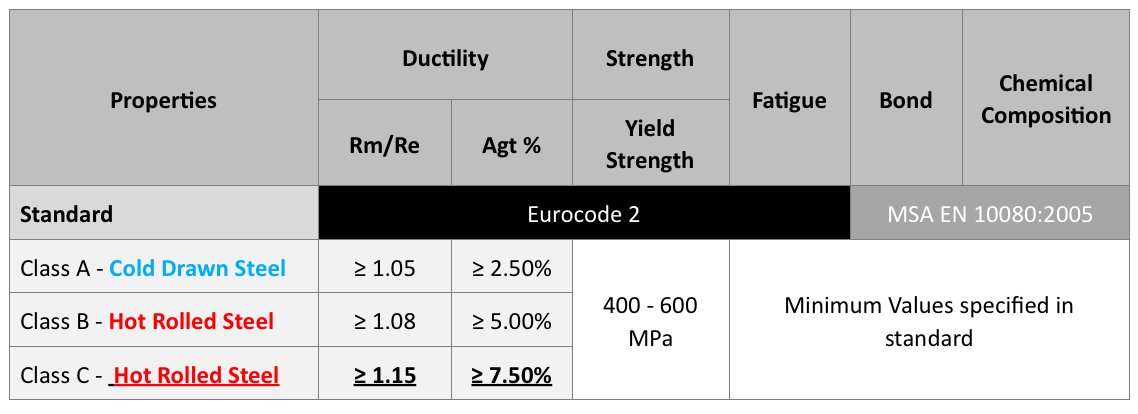
Ductility Class
A major distinction in Eurocode 2 is the three ductility classes that are provided with different lower limits.
- Class A – Low Ductility – Produced from Cold Drawn Wire
- Class B – Medium Ductility, this is a specified grade for reinforcement mesh
- Class C – High Ductility Used for seismic Design, which is a specified Grade for Rebar
In order to assess which ductility grade is achievable, one must verify if the wire used during the production process is cold drawn or hot rolled. This is a key difference that must be observed when choosing the appropriate grade of mesh for steel reinforcement.
Mesh produced from cold drawn wire can only achieve ductility of class A due to intrinsic limitations in the mechanical properties of the wire.
In order to achieve a ductility grade of Class B or above, meshes need to be produced from hot rolled wire. The diagram below illustrates the difference in the production process of the two typologies of wire used:
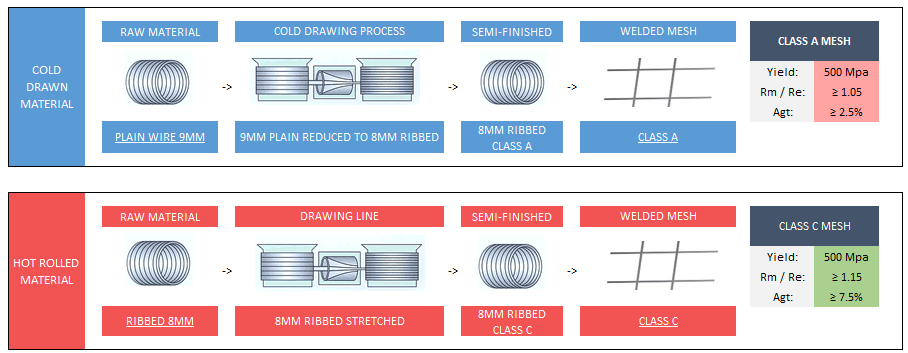
The final difference between the two types of wire can also be seen in the diagram below, which can be found in Eurocode 2.
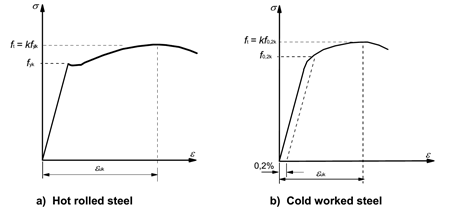
Extract for Eurocode 2 Figure 3.7: Stress-strain diagrams
Identifying Steel on site
When procuring reinforcement, there are various methods and checks that can be used to identify the quality of steel being used.
Diameter and surface geometry
Due to its ribbings, it is sometimes difficult to assess the exact diameter of steel reinforcement on site, especially when dealing with small diameters. Keeping in mind that the presence of 14mm and 24mm bars which are predominantly used in Italian markets, one must ensure that the steel procured is of appropriate diameter. If we take a scenario where a 24mm bar is supplied instead of a specified 25mm, a 1mm reduction would have created a reduction of 8% in the cross-sectional area and strength of the material (as shown in the table below). Furthermore, this is difficult to verify using a Vernier calliper, since a standard H25 bar would vary between 24.5mm in between the ribbings and 26.5mm when taking the outside diameter including the ribbings. In order to verify the exact diameter if steel reinforcement, one must weigh a specimen to assess its weight per meter.
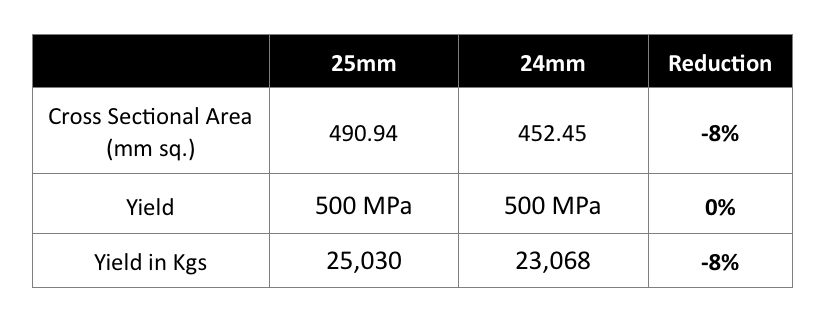
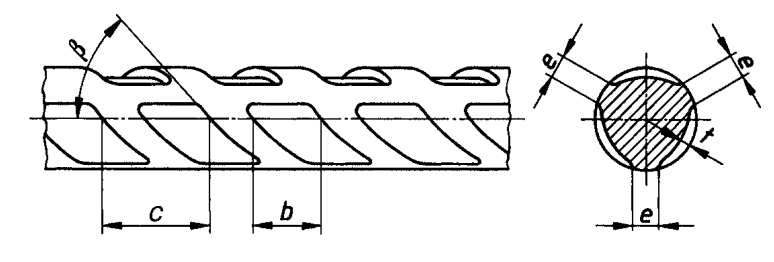
Bending limits
Eurocode 2 also specifies the appropriate mandrels that must be used when bending steel reinforcement. Failure to use such mandrels can cause the material to crack when bending, and cause visible cracks. Bent reinforcement can be easily assessed on site by verifying the diameter of bent areas and also visually checking for any visible cracks in the bent region.
Sampling
Random sampling of supplied reinforcement is perhaps the most crucial verification method. This method of sampling is usually a preferred method by structural engineers as this guarantees that all properties of the steel being procured are being assessed.
Steel Reinforcement Supplied by JMV
How we source our steel:
It is with this knowledge that we are able to source the best quality raw materials. We choose our providers wisely and look for suppliers who we can trust not only to provide us with quality products, but who are trustworthy with respect to the reliability of their expertise, processing procedures and availability of products.
Guaranteeing quality:
Quality is guaranteed through proper certification. This certification is known as a Mill’s Test Certificate (MTC) which certifies the material’s chemical and physical properties, assuring compliance with international materials standards. Such certificates are issued by our suppliers to assure that their products comply with international standards. Moreover, we ensure that these are received with every shipment and stored on our system.
Once on our premises, the material undergoes further processing to meet our client order requirements, which may affect the quality of the material. We also operate a full-traceability system when processing the material. This has the ability to trace the raw material used for every order.
In light of this, together with wanting to ensure that the material maintains its integrity and quality even after undergoing further processing at our premises, the company invested in its own in-house quality assurance laboratory back in 2003, allowing us to further guarantee quality. Material is accompanied with certification.
Steel Reinforcement Grade
Steel supplied by JMV are processed to ductility Class C for both mesh and rebar, achieving the highest possible ductility grade.
For more info contact JMV Sales office at sales@jmvibro.com